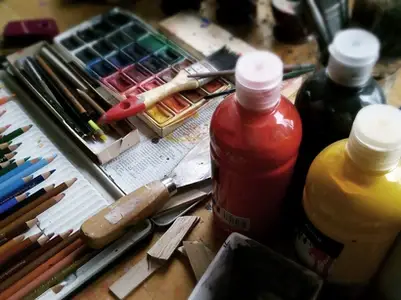As artists, we want to avoid that cliche of a ‘starving artist’, and one of the best ways to do that and earn some great money is doing commissions. Let’s just quickly start with what a commission is: commissions are where someone hires you to create a piece of art of a subject of their choosing. Some common themes of commissions are paintings or drawing of a pet, animal, or a human/family portrait.
Doing commissions are definitely one of the best ways to earn some fast money as an artist, and today, I’m going to be talking you through this 5 step guide to Art Commissions.
1. Finding Commissions
The first step towards getting commissions is to build a strong portfolio. This might be on your own website or on a photo-sharing network like Instagram/Facebook. When developing a portfolio, keep in mind that you want to have a consistent style and focus so that potential clients know exactly what to expect. Include your best work as well as any previous commissions you’ve completed, but don’t forget to prioritise quality over quantity! You can begin publicising your services once you’ve created a portfolio.
Because visibility is important, make sure everyone knows you’re available for commissions. Post frequently on social media, advertise in your locally, and if you’re just getting started, reaching out to friends, family, and local art lovers might be a fantastic place to start.
2. Pricing Your Work
Many artists, especially those just starting out, make the mistake of underselling themselves. Everyone deserves to be adequately compensated for their efforts. By undervaluing your art, you are not only doing yourself a disservice, but you are also hurting the market for other artists. Charging a reasonable fee earns you respect and filters out any bad customers. So, what constitutes fairness? Most artists price their work by multiplying the projected number of hours it will take to finish a piece by their hourly rate, but there are additional factors to consider.
You’ll need to consider the size, number of materials needed, and shipping costs. You might also charge more for extras, such as a quick turnaround or intricate decoration. In a document, clearly outline all of the above criteria so your client can see how you arrived at the figure. Building trust between yourself and your client requires transparency.
3. Coherent Communication
Before accepting a new commission, it’s a good idea to meet in person if you’re local, and of not, then maybe arrange a zoom call. Invite the client to your studio if at all possible so they can view the type of work you’ve done previously. Having examples on available makes it easier for the client to express their desires verbally. Show them several materials and sizes, and ask as many questions as you can to acquire a good image of their needs. It may also be beneficial to describe your work approach so that they are aware of both sides. When addressed as a collaboration rather than a service, commissioning works best.
4. Have a Timeframe
You must be fully honest with yourself in this step. Making promises you can’t fulfil can only lead to burnout and the loss of clients. Be honest with yourself about how long a work will take you to complete. Examine your schedule to determine how much time you can devote to the commission in question, taking into account all of your other obligations. Decide on a reasonable timeframe with your client, and be open and honest about any issues that may occur. Discuss how often you’ll check-in ahead of time, and be enthusiastic when you do so – if you’re enthused about the piece, your customer will be, too!
5. Payment
After you and your customer have agreed on the terms, the following step is to draft a contract that properly describes the project’s details. This should include a description of the work, its size and medium, the agreed-upon charge and payment plan, late payment costs, completion time, and any other pertinent information. When establishing written agreements, it’s a good idea to seek legal guidance if you’re unsure. You could also want to include a ‘death fee’ to protect yourself if the project is cancelled in the middle. It’s standard practice to require up to 50% of the charge upfront at the time of signing, to cover the cost of initial materials and expenses. A monthly payment schedule could be arranged for greater commissions. Receiving paid in advance helps to develop a trustworthy professional connection and guarantees that both parties are committed to the project.
























